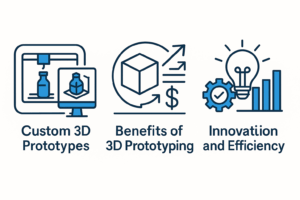
Quick Take: Why Digital Wins
Selling STL files is superior to selling physical prints because it separates your income from your time. While physical prints require material costs, shipping logistics, and constant machine maintenance, digital files have zero reproduction costs, infinite inventory, and can be sold globally 24/7 without your active involvement.
Many 3D printing enthusiasts start their business journey in the same place: an Etsy shop filled with physical trinkets, articulated dragons, and functional parts. It feels productive at first. The printer hums, the orders come in, and you pack boxes.
However, you quickly realize you have created a job, not a business. If your printer jams, your income stops. If you go on vacation, your shop closes.
The true power of 3D printing lies not in manufacturing plastic, but in manufacturing intellectual property. By shifting your focus to selling STL files, you move from a service-based model to a product-based model. This guide explains why digital assets are the key to scaling your 3D printing business.
The “Hamster Wheel” of Physical Printing
Selling physical items involves a linear relationship between time and money. To sell more, you must print more. This model has inherent ceilings that are difficult to break without significant capital investment.
1. The Logistics Nightmare
Shipping is the silent killer of profit margins. You must manage boxes, packing peanuts, labels, and the inevitable “my package arrived broken” emails. International shipping is often too expensive to be viable, severely limiting your customer base.
2. Hardware Failure Points
Your production line is only as strong as your hardware. A clogged nozzle on your Bambu Lab X1C or a leveled bed issue means production halts. You cannot generate revenue while troubleshooting hardware.
3. Inventory and Storage
Even if you print on demand, you need storage for filament, boxes, and rejected prints. Physical goods require physical space.
The Passive Power of STL Files
Digital files operate on a different economic logic. Once the file is created, the cost to sell one copy is the same as the cost to sell one million copies: zero.
- Zero Shipping: Delivery is instant and automated via email or platform download.
- Global Reach: A customer in Tokyo can buy your file as easily as a customer in Texas.
- Infinite Inventory: You never run out of stock.
- Passive Income: Your files sell while you sleep, while you are at your day job, or while you are designing the next project.
Ready to Upgrade Your Gear?
To design high-quality STLs, you need reliable printers for prototyping. I rely on Creality machines for their balance of precision and affordability.
How to Create Value: Design vs. Scanning
You do not need to be a master sculptor to sell files. There are two primary paths to creating digital inventory.
1. CAD and Artistic Design
If you are proficient in Fusion 360, Blender, or Tinkercad, you can solve problems or create art. Functional parts—like brackets for smart home devices or organizers—often sell better than artistic statues because they solve a specific pain point.
2. 3D Scanning and Reverse Engineering
This is a massive opportunity often overlooked. By scanning real-world objects (where legal) or creating custom fits for existing objects (like car dashboards or tool handles), you can create highly accurate models that are impossible to design from scratch by eye.
For high-fidelity scanning, I recommend 3DMakerPro scanners. They offer professional-grade precision that captures the intricate details needed for commercial-quality STLs.
Explore 3DMakerpro Global Scanners Here
Where to Sell Your Files
Don’t rely on a single platform. Diversify your income streams by listing your digital assets on multiple marketplaces.
- Cults3D: High traffic, though fees can be higher. Great for artistic models.
- MyMiniFactory: Excellent for tabletop gaming and high-quality curated content.
- Printables/Thangs: These platforms are introducing monetization models that reward designers based on engagement and club memberships.
- Your Own Site: Selling directly on 3dprintingbykevin.com allows you to keep 100% of the profit and build an email list.
Conclusion,
Transitioning from selling physical prints to selling STL files is a shift from being a laborer to being a creator. It requires upfront effort to learn design or scanning, but the long-term payoff is a business that scales without limit. Start by designing one solution, upload it, and let the internet do the heavy lifting.
Frequently Asked Questions
Can I sell 3D files of copyrighted characters?
No. Selling STL files of copyrighted characters (like Marvel or Disney) is illegal and can result in your shop being banned or legal action. Always create original designs.
What is the best file format to sell?
STL is the industry standard. However, including a STEP file (for easier modification) or a pre-supported 3MF file adds value and allows you to charge a premium.
How much should I charge for an STL file?
Simple functional parts often sell for $2-$5. Complex artistic models or full cosplay armor sets can sell for $20-$50. Look at your competition on Cults3D to gauge the market.

